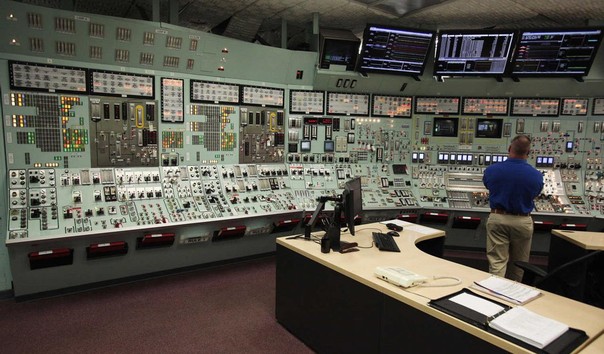
Progress Energy considering closing Crystal River nuclear plant
MICHAEL SASSO | The Tampa Tribune
It helped put this tiny city on the map and powered thousands of West Central Florida homes, but is the nuclear power plant here more trouble than it's worth?
Progress Energy officials may decide within weeks whether to shut down the Crystal River 3 nuclear plant permanently. Many Tampa Bay-area residents might not know it, but this plant, just inland from the Gulf of Mexico, hasn't churned out a megawatt of electricity in more than a year and a half.

Pool
Warren Gill monitors the control room at the Crystal River 3 nuclear power plant on Tuesday. Progress Energy soon could decide whether to continue running the plant, which hasn't generated electricity in more than a year and a half.
Mounting costs to fix the plant have Progress Energy officials wondering whether to keep pumping money into it or shut it and rebuild a non-nuclear plant in its place.
In September 2009, the company found "delamination" — slightly different than cracking — in the concrete building surrounding the reactor. Since then, Progress Energy has spent tens of millions on repairs and countless hours trying to figure out how to fix it.
The question now is whether it's worth it to keep trying. Progress Energy expects to have an idea about the plant's future by June 27, and if it chooses to decommission it, the west coast of Florida may lose its only nuclear plant.
On Tuesday, Progress Energy walked local newspaper and TV reporters through Crystal River 3, which gets its name from being the third of five electric plants in Crystal River. The other four burn coal to generate power. Progress Energy didn't explain why it hosted the media tour, but the company might be trying to counter some of the bad vibes surrounding nuclear energy since the Fukushima Dai-ichi disaster in Japan.
Plant officials say Crystal River 3 is prepared for the worst Mother Nature or terrorists can throw at it. Concrete walls 42 inches thick surround its nuclear reactor and theoretically could withstand winds from a Category 5 hurricane or a tornado with 360-mph winds. A direct strike from a 747 jetliner wouldn't collapse the walls, either, company official say.
The plant sits 30.5 feet above sea level, which Progress Energy thinks protects it against hurricane storm surge.
A Category 5 storm could generate surge above 30 feet and surround the plant, according to worst-case projections from Citrus County officials. However, the plant has watertight doors that make it resistant to 40.5 feet of water, Progress Energy Vice President Jon Franke said.
Surprisingly, the hourglass-shaped smokestacks that rise from the flat, brushy landscape here aren't part of the nuclear power plant. They actually help cool two of Progress Energy's adjacent coal-fired power plants.
Crystal River 3's most striking feature is its spent-fuel pool, a 43-foot-deep basin of water that sits a few stories above ground and indoors. It's easy to know how much radioactivity is left in the uranium rods at the pool's bottom: Spent rods appear a dull brown; new uranium gives off a white shine.
Progress Energy officials say they are working on the problem of what to do with the spent fuel in the long term. By 2013, they hope to have completed a dry storage facility to house some of the spent uranium.
For now, it's not clear whether the Crystal River 3 nuclear plant will be operating then, whatever it does with its spent fuel.
The bill for the repairs: $150 million through 2010. Also, it has cost the company $290 million to buy electricity to replace the power the nuclear plant isn't generating. Progress Energy's insurance company has covered $181 million of that cost.
Company officials may seek to be reimbursed by their customers for losses its insurer doesn't cover, a process that must be approved by Florida's Public Service Commission.
msasso@tampatrib.com (813) 259-7865
June 15, 2011
